Zucchini is a wonderful type of squash, useful in cooking a lot of dishes. If you’re growing zucchini, you obviously want your plant to produce as much fruit as possible.
So when your zucchini plant is flowering but not producing, it can be frustrating. Why is this happening? What can you do about it?
In this article, I’ll talk about why zucchini plants flower but don’t produce, as well as what you can do to help your plant grow more healthy zucchinis.
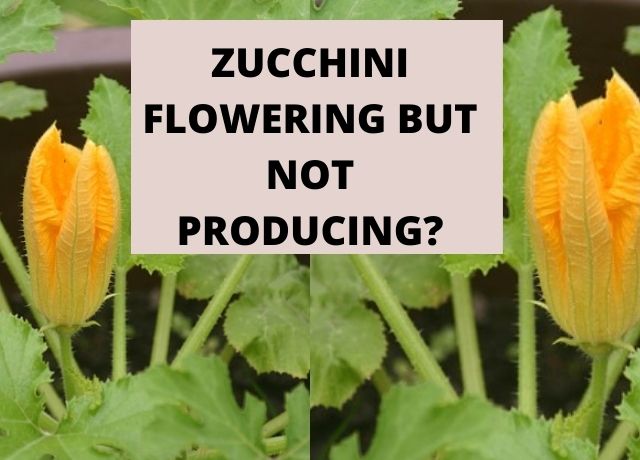
The most common reason for zucchini plants flowering but not producing is poor pollination. However, watering problems, too much heat, and lack of fertilizer can also cause this issue.
So what can you do about each of these problems? Let’s take a look!
Table of Contents
Poor Pollination of Zucchini Plants
This is the number one cause of zucchinis flowering but not producing fruit. If you’re having this problem, you should always consider pollination first.
Zucchini plants produce both male and female flowers on the same plant. Male flowers have a long, thin stem, inside of which is the pollen that the female flowers need. Female flowers are easily identifiable because they have a small bump below the flower, which is the unfertilized zucchini fruit.
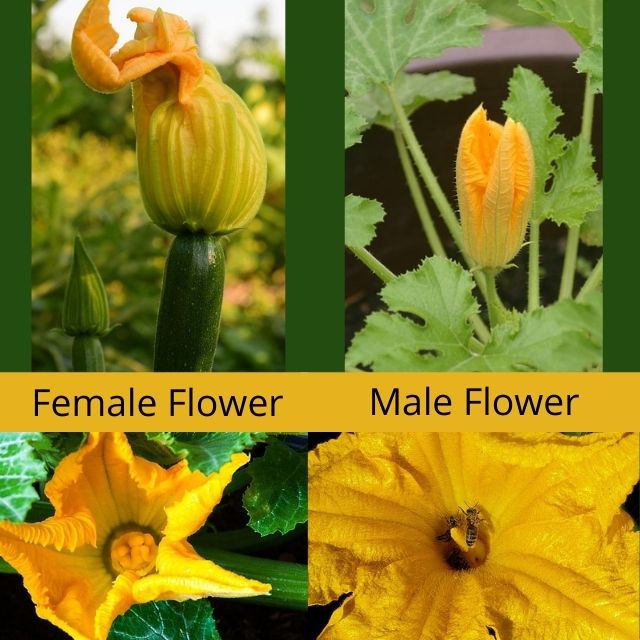
In order for a zucchini plant to grow successful zucchinis, it needs pollen to be transferred from male flowers to female flowers. This usually happens naturally, but if it isn’t occurring, you might have to step in.
The first thing you can do is try to attract more pollinators to your garden. Plant lots of bright, blooming, pollen-filled flowers to attract honeybees, who will do the important work of pollinating your zucchini.
Make sure you’re not accidentally harming bees either. Avoid sticky traps or netting, which will keep bees from reaching your plants. Also avoid using insecticides that might harm local bees.
If the bees just aren’t doing enough, or there aren’t enough of them, you can also hand-pollinate your zucchini plants.
To do this, get a small paintbrush. Find a male flower and gently stick the paintbrush inside, swirling it around a few times to get it covered in pollen. Then, go to a female flower, and once again stick the brush inside and swirl it around.
This will transfer pollen to the female flowers, just as if a bee were doing it. Typically, one male flower can be used to pollinate three female flowers.
Remember, attracting pollinators is always your best bet, but if that isn’t working you can also do the work yourself to help your zucchini produce more.
Related: Growing Zucchini: Planting, Caring, And Harvesting Zucchini | 11 Zucchini Pests (And How to Get Rid of Them!)
Zucchini Plants Producing Only Male Flowers
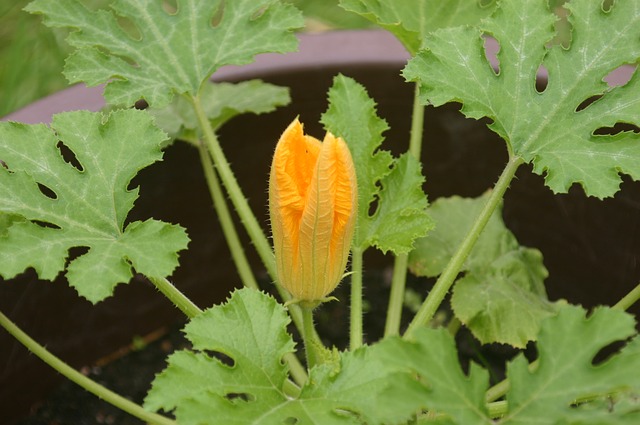
Sometimes, the reason your zucchinis aren’t getting pollinated is simple: there are no female flowers!
This doesn’t necessarily mean you should panic. Most zucchini plants do this naturally. After they start flowering, they only produce male flowers for one to two weeks, and then start producing female flowers too.
So, if your zucchini just started flowering, don’t worry if you’re only seeing male flowers. The female flowers should come soon.
However, if it’s been a few weeks or more and you don’t have female flowers, then you know something is wrong. You should start to consider some of the other issues mentioned in this article.
Scaring Off Pollinators With Water
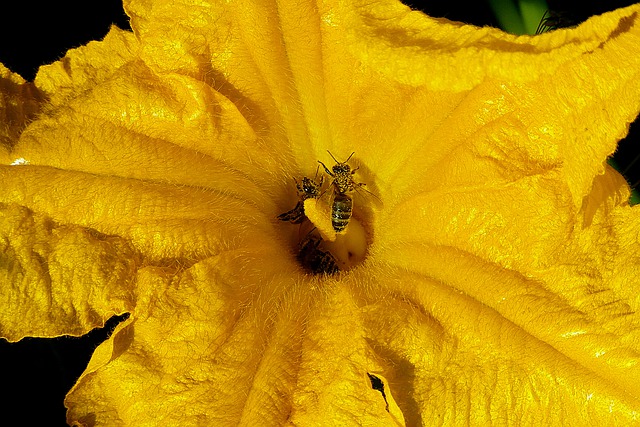
Like sticky traps and netting, there’s another way that you can scare off pollinators. This is one people often do accidentally: watering your zucchini plants at the wrong time.
You see, pollinators like bees are most active in the early hours of the morning. If you water your zucchini every day at this time, it could scare them away from the plants.
Having sprinklers that go off at this time is even more likely to keep bees away, and not as effective for watering. So be mindful of your watering practices for your zucchini.
Consider that zucchini only needs to be watered around three times per week. During this watering, you should provide a nice drench for the soil.
So, while you should water in the morning, you don’t have to water every morning. Give your zucchini plants heavy waterings every few days to leave room for bees to come in and do their work.
If you do have to water every day because of heat, try to do it very early, and only water the base of the plants when possible. You want to try your best not to bother the bees who are helping you pollinate your zucchini.
Temperature Too High For Zucchinis
Another common reason for zucchini plants to flower but not produce fruit is that it’s simply too hot for them.
Once daytime temperatures get above 90 °F (32 °C), or nighttime temperatures above 75 °F (24 °C), zucchini plants start to struggle. They produce much better in temperatures below this.
When zucchinis get too hot, they don’t put the energy needed into fertilization, so even if they’re getting pollinated, they won’t produce fruit like you want. There are two things you can do about this.
First, plant zucchini early enough that they have time to start producing before it gets too hot in the season. When exactly this is will depend on where you live, but make sure they aren’t outside before the last frost, and that there’s no risk of freezing once you put them outside.
If it does get hot, especially earlier than you’re expecting, you can try to counteract the heat by watering more. Allowing the soil to dry out will make it harder for zucchinis to produce. So make sure that it never completely dries out.
Remember, also, that watering too frequently can mess with pollinators. Try to find a balance that allows bees time to work and doesn’t let your zucchini’s soil dry out.
Not Enough Fertilizer For Zucchini Plants
Zucchini plants need a lot of fertilizer, especially nitrogen, when working on producing fruit. If zucchinis are under-fertilized, the fruit might not form correctly, or might not start forming at all.
When your zucchini plants start to flower, you should give them extra fertilizer to help them out. Make sure it is a nitrogen-heavy fertilizer so they get exactly what they need.
Many tomato fertilizers are nitrogen-heavy. You can also use a blood meal like this, which is rich in nitrogen for your zucchinis.
If you have been fertilizing your plants and they’re still not producing, consider using a soil test kit to see if the soil has enough nitrogen in it. You don’t want to add more fertilizer unless you know you need it, because overfertilizing can also harm plants.
- Further reading: Zucchini Leaves Turning Yellow: Causes and Solutions
Overwatering Zucchini Plants
Just like you don’t want the soil to dry out, it’s also possible to give zucchinis too much water. When this happens, root rot can sometimes develop.
When zucchinis are dealing with root rot, it’s common for them to bloom and not produce fruit, because they don’t have enough resources for it.
Sadly, once root rot sets in, it can be hard to treat. Try gently digging up the zucchini plant, clearing away infected roots, and letting the roots die out for a few hours. However, because zucchinis have fragile roots, this could damage them.
The best thing to do for root rot is to prevent it in the first place. Only water zucchini plants when the top inch of soil has dried out, and make sure it can drain well.
Adding mulch around the zucchini plant can also help regulate water levels, helping protect against overwatering.
- Related Reading: 12 Zucchini Plant Diseases And How To Fix Them
Choosing Parthenocarpic Zucchini Varieties
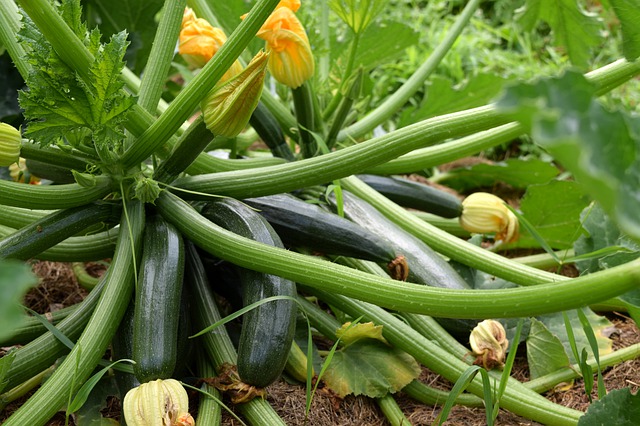
If you’re still having problems with zucchini plants flowering but not producing, or you want to avoid some of these issues, there is another very reliable solution.
Some varieties of zucchini, such as Parthenon, Cavili, Venus, and Sure Thing, are what’s known as parthenocarpic. These varieties are great for producing zucchini in tough conditions, or when you’ve been having issues with flowering but not producing.
Parthenocarpic zucchini varieties have female flowers that can fruit without any kind of pollination. This removes a lot of the issues with producing and practically guarantees a higher yield.
These plants still produce male flowers, but not as often, so you get even more female flowers. The fruit won’t have seeds in it, unless it happens to be pollinated. However, the fruit produced is otherwise identical to seeded zucchini varieties.
Because they produce more female flowers, these zucchini plants also usually have a higher yield than non-parthenocarpic varieties.
However, because these zucchini fruits don’t have seeds, it means you can’t save seeds for future use. If you prefer to grow heirloom fruits and vegetables, you won’t be able to do that with these zucchini varieties.
If you’re struggling to get zucchini plants to produce, or know your environmental conditions aren’t the best, consider trying out parthenocarpic zucchinis to have more success.
Some Favorite Gardening Products
- Organic Vegetable Garden Fertilizer
- Soil pH, Water and Light Gauge
- Soil Thermometer
- Organic Seed Raising Soil Mix
- Organic Potting Mix
- Horticultural Neem Oil
Further reading:
